A Series of Acute Psychological Priming Interventions Assessing Changes in Hormonal and Physical Performance Measures During Resistance Training
Abstract
1. Introduction
2. Methods
2.1. Participants
2.2. Procedures
2.3. Saliva Sampling
2.4. Motivational Self-Talk with Imagery
2.5. Self-Selected Music
2.6. Observer Effect and Social Media
2.7. Back Squat
2.8. 4RM Bench Press
2.9. Statistical Analysis
3. Results
3.1. Study 1
3.2. Study 2
3.3. Study 3
4. Discussion
4.1. Study 1
4.2. Study 2
4.3. Study 3
5. Limitations
6. Conclusions
Author Contributions
Funding
Data Availability Statement
Conflicts of Interest
References
- Jeffreys, I. Warm-up revisited: The ramp method of optimizing warm-ups. Prof. Strength Cond. 2007, 6, 12–18. [Google Scholar]
- McCrary, J.; Ackermann, B.; Halaki, M. A systematic review of the effects of upper body warm-up on performance and injury. Br. J. Sports Med. 2016, 49, 935–942. [Google Scholar] [CrossRef]
- McGowen, C.; Pyne, D.; Thompson, K.; Rattray, B. Warm-up strategies for sport and exercise: Mechanisms and applications. Sports Med. 2015, 45, 1523–1546. [Google Scholar] [CrossRef]
- Brewer, B.W.; Haznadar, A.; Katz, D.; Van Raalte, J.L.; Petitpas, A.J. A mental warm-up for athletes. Sport Psychol. 2018, 33, 213–220. [Google Scholar] [CrossRef]
- Pain, M.; Harwood, C. Knowledge, and perceptions of sport psychology within English soccer. J. Sports Sci. 2004, 22, 9. [Google Scholar] [CrossRef] [PubMed]
- Tod, D.; Edwards, C.; McGuigan, M.; Lovell, G. A systematic review of the effect of cognitive strategies on strength performance. Sports Med. 2015, 45, 1589–1602. [Google Scholar] [CrossRef] [PubMed]
- Collins, J.; Bishop, C.; Hills, F.; Spiegelhalter, A.; Cohen, A.; Turner, A. A survey into the use of priming techniques implemented by athletes and coaches to improve athletic performance. J. Strength Cond. Res. 2022, 37, 107–113. [Google Scholar] [CrossRef]
- Petit, J.; Karageorghis, C. Effects of video, priming, and music on motivation and self-efficacy in American football players. Int. J. Sports Sci. Coach. 2020, 15, 685–695. [Google Scholar] [CrossRef]
- Karageorghis, C.I.; Priest, D.L. Music in the exercise domain: A review and synthesis (part i). Int. Rev. Sport Exerc. Psychol. 2012, 5, 44–66. [Google Scholar] [CrossRef]
- Karageorghis, C. Applying Music in Exercise and Sport; Human Kinetics: Champaign, IL, USA, 2017. [Google Scholar]
- Moss, S.; Enright, K.; Cushman, S. The influence of music genre on explosive power, repetitions to failure and mood responses during resistance training. Psychol. Sport Exerc. 2018, 37, 128–138. [Google Scholar] [CrossRef]
- Silva, N.R.D.S.; Rizardi, F.G.; Fujita, R.A.; Villalba, M.M.; Gomes, M.M. Preferred music genre benefits during strength tests: Increased maximal strength and strength-endurance and reduced perceived exertion. Percept. Mot. Ski. 2020, 128, 324–337. [Google Scholar] [CrossRef] [PubMed]
- Bartolomei, S.; Michele, R.D.; Merni, F. Effects of self-selected music on maximal bench press strength and strength endurance. Percept. Mot. Ski. 2015, 120, 714–721. [Google Scholar] [CrossRef]
- Blanchfield, A.; Hardy, J.; de Morree, H.M.; Staiano, W.; Marcora, S.M. Talking yourself out of exhaustion: The effects of self-talk on endurance performance. Med. Sci. Sports Exerc. 2013, 46, 998–1007. [Google Scholar] [CrossRef] [PubMed]
- Hardy, J. Speaking clearly: A critical review of the self-talk literature. Psychol. Sport Exerc. 2006, 7, 81–97. [Google Scholar] [CrossRef]
- Hatzigeorgiadis, A.; Zourbanos, N.; Galanis, E.; Theodorakis, Y. Self-talk and sports performance: A meta-analysis. Perspect. Psychol. Sci. 2011, 6, 348–356. [Google Scholar] [CrossRef]
- Tod, D.; Hardy, J.; Oliver, E.J. Effects of self-talk: A systematic review. J. Sport Exerc. Psychol. 2011, 33, 666–687. [Google Scholar] [CrossRef]
- Hardy, J.; Oliver, E.; Tod, D. A framework for the study and application of self-talk within sport. In Advances in Applied Sport Psychology: A Review; Mellalieu, S., Hanton, S., Eds.; Routledge: London, UK, 2009; pp. 37–74. [Google Scholar]
- Theodorakis, Y.; Weinberg, R.; Natsis, P.; Douma, I.; Kazakas, P. The effects of motivational versus instructional self-talk on improving motor performance. Sport Psychol. 2000, 14, 253–272. [Google Scholar] [CrossRef]
- Holmes, P.; Collins, D. The PETTLEP approach to imagery: A functional equivalence model for sports psychologists. J. Appl. Sport Psychol. 2001, 13, 60–83. [Google Scholar] [CrossRef]
- Slimani, M.; Cheour, F.; Moalla, W.; Baker, J. Hormonal responses to a rugby match: A brief review. J. Sports Med. Phys. Fit. 2017, 58, 5. [Google Scholar] [CrossRef]
- Simonsmeier, B.; Andronie, M.; Buecker, S.; Frank, C. The effects of imagery interventions in sports: A meta-analysis. Int. Rev. Sport Exerc. Psychol. 2021, 14, 186–207. [Google Scholar] [CrossRef]
- Hardy, J.; Gammage, K.; Hall, C. A descriptive study of athlete self-talk. Sport Psychol. 2001, 15, 306–318. [Google Scholar] [CrossRef]
- Robin, N.; Dominique, L.; Guillet-Descas, E.; Hue, O. Beneficial effects of motor imagery and self-talk on service performance in skilled tennis players. Front. Psychol. 2022, 13, 778468. [Google Scholar] [CrossRef] [PubMed]
- Tennie, C.; Frith, U.; Frit, C.D. Reputation management in the age of the World Wide Web. Trends Cogn. Sci. 2010, 14, 482–488. [Google Scholar] [CrossRef] [PubMed]
- Chen, I.-C.; Hill, J.K.; Ohleüller, R.; Roy, D.B.; Thomas, C.D. Rapid range shifts of species associated with high levels of climate warming. Science 2011, 333, 1024–1026. [Google Scholar] [CrossRef]
- Zajonc, R.B. Social facilitation. Science 1965, 149, 269–274. [Google Scholar] [CrossRef] [PubMed]
- Baker, S.; Jung, A.; Petrella, J. Presence of Observers Increases One Repetition Maximum in College-age Males and Females. Int. J. Exerc. Sci. 2011, 4, 199–203. [Google Scholar] [CrossRef]
- Walter, N.; Nikoleizig, L.; Alfermann, D. Effects of self-talk on competitive anxiety, self-efficacy, volitional skills, and performance: An intervention study with junior sub-elite athletes. Sports 2019, 7, 148. [Google Scholar] [CrossRef]
- Mazur, A.; Booth, A. Testosterone and dominance in men. Behav. Brain Sci. 1998, 21, 353–363. [Google Scholar] [CrossRef]
- McCall, C.; Singer, T. The animal and human neuroendocrinology of social cognition, motivation, and behavior. Nat. Neurosci. 2012, 15, 681–688. [Google Scholar] [CrossRef]
- Stanton, S.J.; Mullette-Gillman, O.D.A.; McLaurin, R.E.; Kuhn, C.M.; LaBar, K.S.; Platt, M.L.; Huettel, S.A. Low and high-testosterone individuals exhibit decreased aversion to economic risk. Psychol. Sci. 2011, 22, 447–453. [Google Scholar] [CrossRef]
- Van Honk, J.; Peper, J.; Schutter, D.J. Testosterone reduces unconscious fear but not consciously experienced anxiety: Implications for the disorders of fear and anxiety. Biol. Psychiatry 2005, 58, 218–225. [Google Scholar] [CrossRef]
- Ishak, M.W.; Herrera, N.; Halbert, A.; Tu, J.; Gao, W. Music and biomarkers of stress: A systematic review. Int. J. Healthc. Med. Sci. 2020, 6, 82–92. [Google Scholar] [CrossRef]
- Janak, P.; Tye, K.; Sciences, B.; Sciences, C. From circuits to behavior in the amygdala. Nature 2015, 517, 284–292. [Google Scholar] [CrossRef]
- Schultheiss, O.; Campbell, K.; McClelland, D. Implicit power motivation moderates men’s testosterone responses to imagined and real dominance. Horm. Behav. 1999, 36, 234–241. [Google Scholar] [CrossRef] [PubMed]
- Wang, Z.; Mick, G.; Wang, X.; Xie, X.; Li, G.; McCormick, K.L. Cortisol promotes endoplasmic glucose production via pyridine nucleotide redox. J. Endocrinol. 2016, 229, 25–26. [Google Scholar] [CrossRef] [PubMed]
- Turner, A.; Comfort, P.; Moody, J.; Jeffreys, I. Neuroendocrinology and resistance training in adult males. UK Strength Cond. Assoc. 2010, 17, 15–24. [Google Scholar]
- Kraemer, W.; Fleck, S.; Dziados, J.; Harmen, E.; Marchitelli, L.; Gordon, S.E.; Mello, R.; Frykman, P.N.; Koziris, L.P.; Triplett, N.T. Changes in hormonal concentrations after different heavy-resistance exercise protocols in women. J. Appl. Physiol. 1991, 75, 594–604. [Google Scholar] [CrossRef]
- Tod, D.; Iredale, F.; Gill, N. “Psyching-up” and muscular force production. Sports Med. 2003, 33, 47–58. [Google Scholar] [CrossRef]
- Jezová, A.; Vigas, M.; Tatár, P.; Kvetnansky, R.; Nazar, K.; Kaciuba-Uścilko, H.; Kozlowski, S. Plasma testosterone and catecholamine responses to physical exercise of different intensities in men. Eur. J. Appl. Physiol. Occup. Physiol. 1985, 54, 62–66. [Google Scholar] [CrossRef]
- Cook, C.; Crewther, B.T. The social environment during a post-match video presentation affects the hormonal responses and playing performance of professional male athletes. Physiol. Behav. 2014, 130, 170–175. [Google Scholar] [CrossRef]
- Brownlee, K.K.; Moore, A.W.; Hackney, A.C. Relationship between circulating cortisol and testosterone: Influence of physical exercise. J. Sports Sci. Med. 2005, 4, 76–83. [Google Scholar]
- Cumming, D.C.; Quigley, M.E.; Yen, S.C. Acute suppression of circulating testosterone levels by cortisol in men. J. Clin. Endocrinol. Metab. 1983, 57, 671–673. [Google Scholar] [CrossRef]
- Cook, C.; Crewther, B.T. The effects of different pre-game motivational interventions on athlete free hormonal state and subsequent performance in professional rugby union matches. Physiol. Behav. 2012, 106, 683–688. [Google Scholar] [CrossRef]
- Kraemer, W.; Loebel, C.; Volek, J.; Ratamess, N.; Newton, R.; Wickham, R.; Häkkinen, K. The effect of heavy resistance exercise on the circadian rhythm of salivary testosterone in men. Eur. J. Appl. Physiol. 2001, 84, 13–18. [Google Scholar] [CrossRef]
- Stanton, S.J. Assessment of salivary hormones. Methods Neurosci. 2009, 17–44. [Google Scholar]
- Winkelman, N. Attentional Focus and Cueing for Speed Development. Strength Cond. J. 2018, 40, 13–25. [Google Scholar] [CrossRef]
- Hall, C.R.; Munroe-Chandler, K.J.; Cumming, J.; Law, B.; Ramsey, R.; Murphy, L. Imagery and observational learning use and their relationship to sport confidence. J. Sports Sci. 2009, 27, 327–337. [Google Scholar] [CrossRef] [PubMed]
- Noordin, S.; Cumming, J. Types and functions of athletes’ imagery: Testing predictions from the applied model of imagery use by examining effectiveness. Int. J. Sport Exerc. Psychol. 2008, 6, 189–206. [Google Scholar] [CrossRef]
- Terry, P.; Karageorghis, C. Psychophysical effects of music in sport and exercise: An update on theory, research, and application. In Joint Conference of the Australian Psychological Society and the New Zealand Psychological Society; Melbourne Publishers: Melbourne, Australia, 2006; pp. 414–419. [Google Scholar]
- Karageorghis, C.; Terry, P. The psychophysical effects of music in sport and exercise: A review. J. Sport Behav. 1997, 20, 54–68. [Google Scholar]
- Sherman, L.E.; Payton, A.A.; Hernandez, L.M.; Greenfield, P.M.; Dapretto, M. The power of the like in adolescence: Effects of peer influence on neural and behavioral responses to social media. Psychol. Sci. 2016, 27, 1027–1035. [Google Scholar] [CrossRef]
- Sheppard, J.M.; Triplett, N.T. Program design for resistance training. In Essentials of Strength Training and Conditioning, 4th ed.; Haff, G.G., Triplett, N.T., Eds.; Human Kinetics: Champaign, IL, USA, 2016; pp. 689–701. [Google Scholar]
- Coutts, A.; Reaburn, P.; Piva, T.; Murphy, A. Changes in selected biomechanical, muscular strength, power, and endurance measures during deliberate overreaching and tapering in rugby league players. Int. J. Sports Med. 2007, 28, 116–124. [Google Scholar] [CrossRef]
- Baechle, T.R.; Earle, R.W. Essentials of Strength Training and Conditioning, 3rd ed.; Human Kinetics: Champaign, IL, USA, 2008; pp. 379–380. [Google Scholar]
- Field, A. Discovering Statistics Using IBM SPSS Statistics; Sage: London, UK, 2013. [Google Scholar]
- Crewther, B.T.; Cook, C.; Cardinale, M.; Weatherby, R.; Lowe, T. Two emerging concepts for elite athletes: The short-term effects of testosterone and cortisol on the neuromuscular system and the dose-response training role of these endogenous hormones. Sports Med. 2011, 41, 103–123. [Google Scholar] [CrossRef]
- Turner, A.; Kilduff, L.; Marshall, G.; Phillips, J.; Noto, A.; Buttigieg, C.; Marcela, G.; Hills, F.A.; Dimitriou, L. Competition intensity and fatigue in elite fencing. J. Strength Cond. Res. 2017, 31, 3128–3136. [Google Scholar] [CrossRef]
- Montoya, E.; Terburg, D.; van Honk, J.; Bos, P. Testosterone, cortisol, and serotonin as key regulators of social aggression: A review and theoretical perspective. Motiv. Emot. 2011, 36, 75–93. [Google Scholar] [CrossRef] [PubMed]
- Cohen, J. A power primer. Psychol. Bull. 1992, 112, 155–159. [Google Scholar] [CrossRef] [PubMed]
- Hedge, L.V.; Olkin, I. Statistical Methods for Meta-Analysis; Academic Press: Orlando, FL, USA, 2014; p. 86. [Google Scholar]
- Crewther, B.T.; Cook, C.J.; Gaviglio, C.M.; Kilduff, L.P.; Drawer, S. Baseline strength can influence the ability of salivary free testosterone to predict squat and sprinting performance. J. Strength Cond. Res. 2012, 26, 261–268. [Google Scholar] [CrossRef] [PubMed]
- West, D.W.D.; Phillips, S.M. Associations of exercise-induced hormone profiles and signs of strength and hypertrophy in a large cohort after weight training. Eur. J. Appl. Physiol. 2012, 112, 693–702. [Google Scholar] [CrossRef]
- Weakly, J.; Bryan, M.; Banyard, B.; McLaren, S.; Scott, T.; Garcia-Ramos, A. Velocity-based training: From theory to application. Strength Cond. J. 2021, 43, 31–49. [Google Scholar] [CrossRef]
- Cook, C.J.; Crewther, B.T.; Kilduff, L.P. Are free testosterone and cortisol concentrations associated with training motivation in elite male athletes? Psychol. Sport Exerc. 2013, 14, 882–885. [Google Scholar] [CrossRef]
- Cook, C.J.; Beaven, C.M. Salivary testosterone is related to self-selected training load in elite female athletes. Physiol. Behav. 2013, 116–117, 8–12. [Google Scholar] [CrossRef]
- Alexander, S.E.; Abbot, G.; Aisbett, B.; Wadley, G.D.; Hnatiuk, J.A.; Lamon, S. Total testosterone is not associated with lean mass or handgrip strength in pre-menopausal females. Nature 2021, 11, 10226. [Google Scholar] [CrossRef]
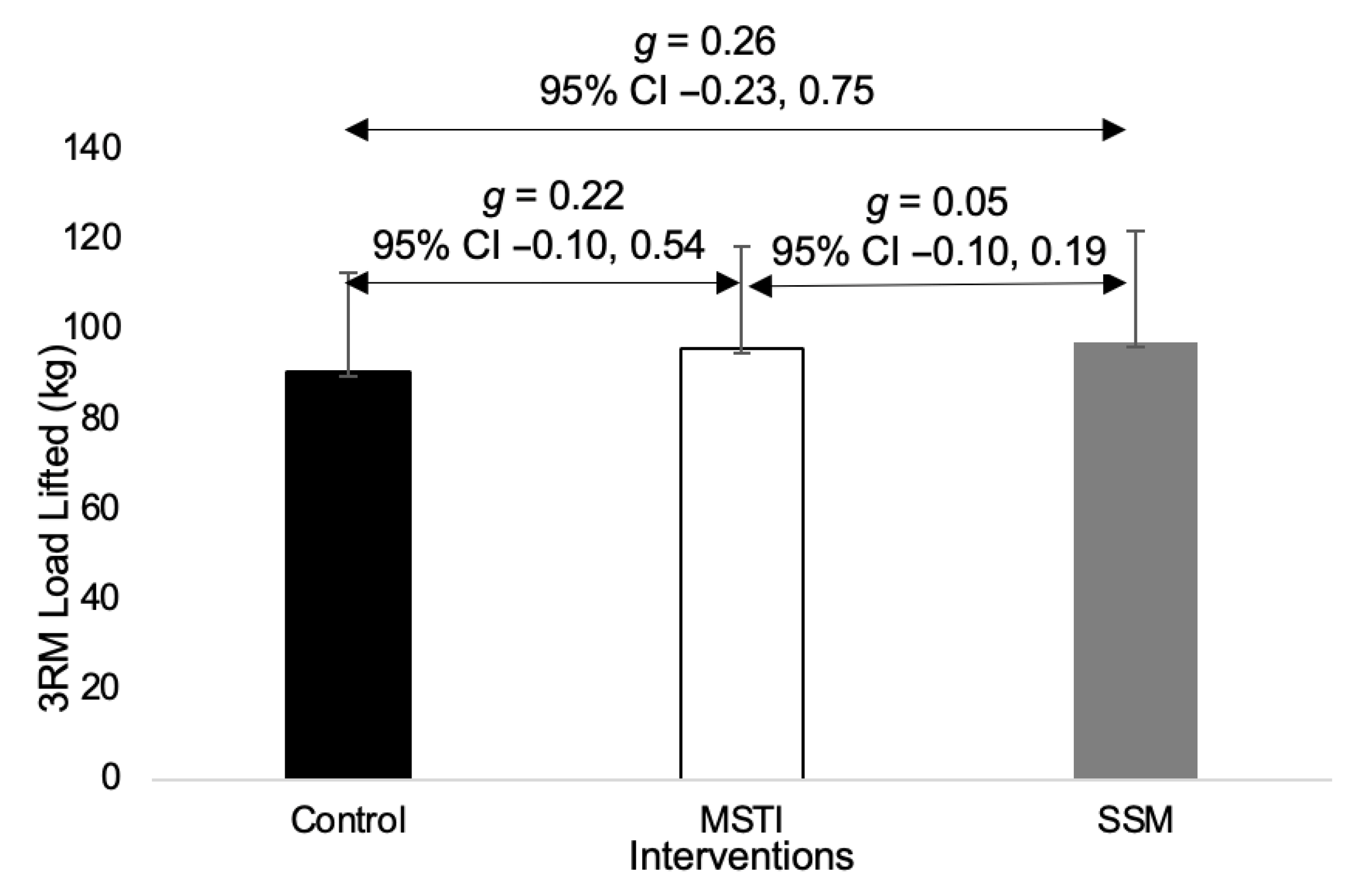
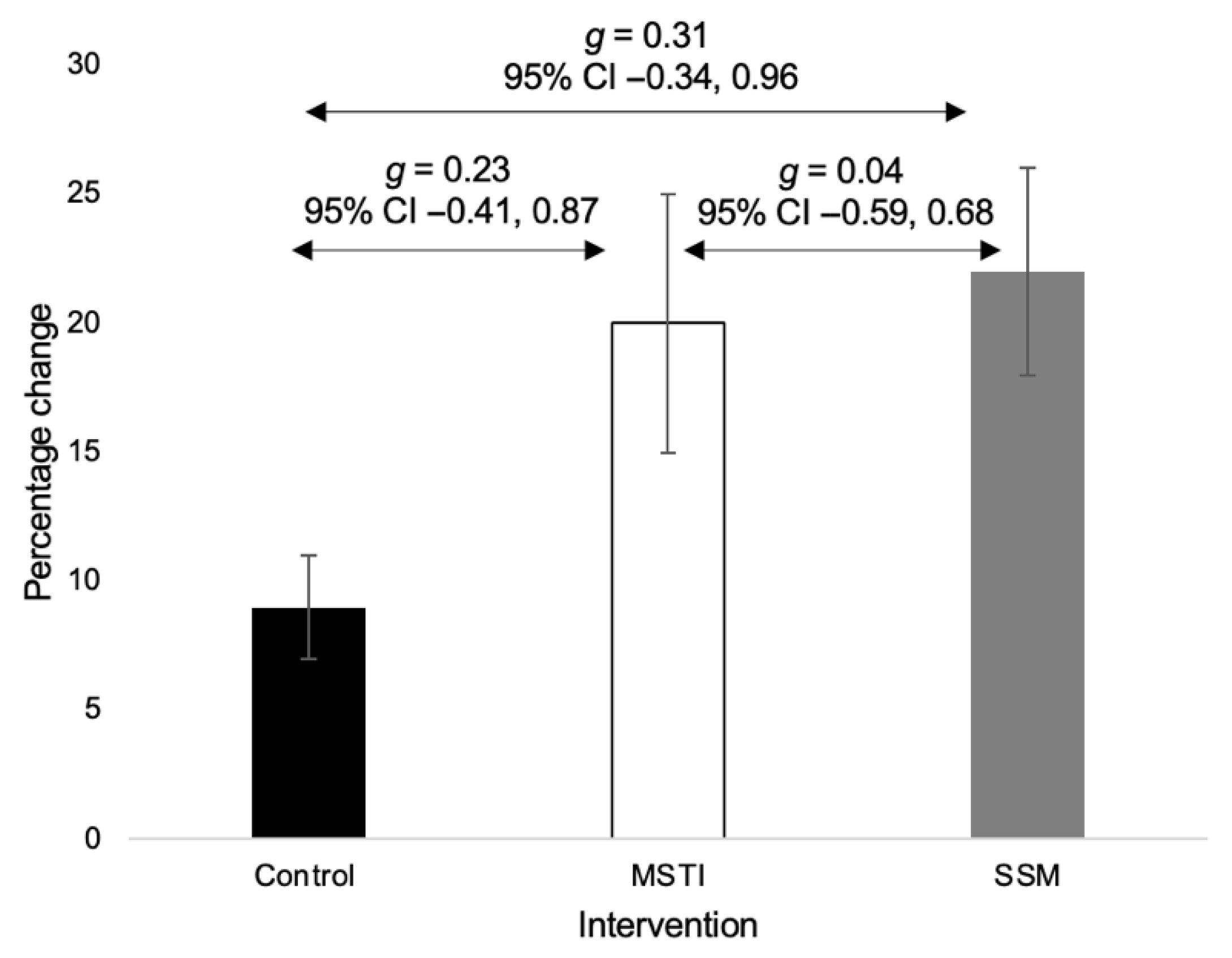

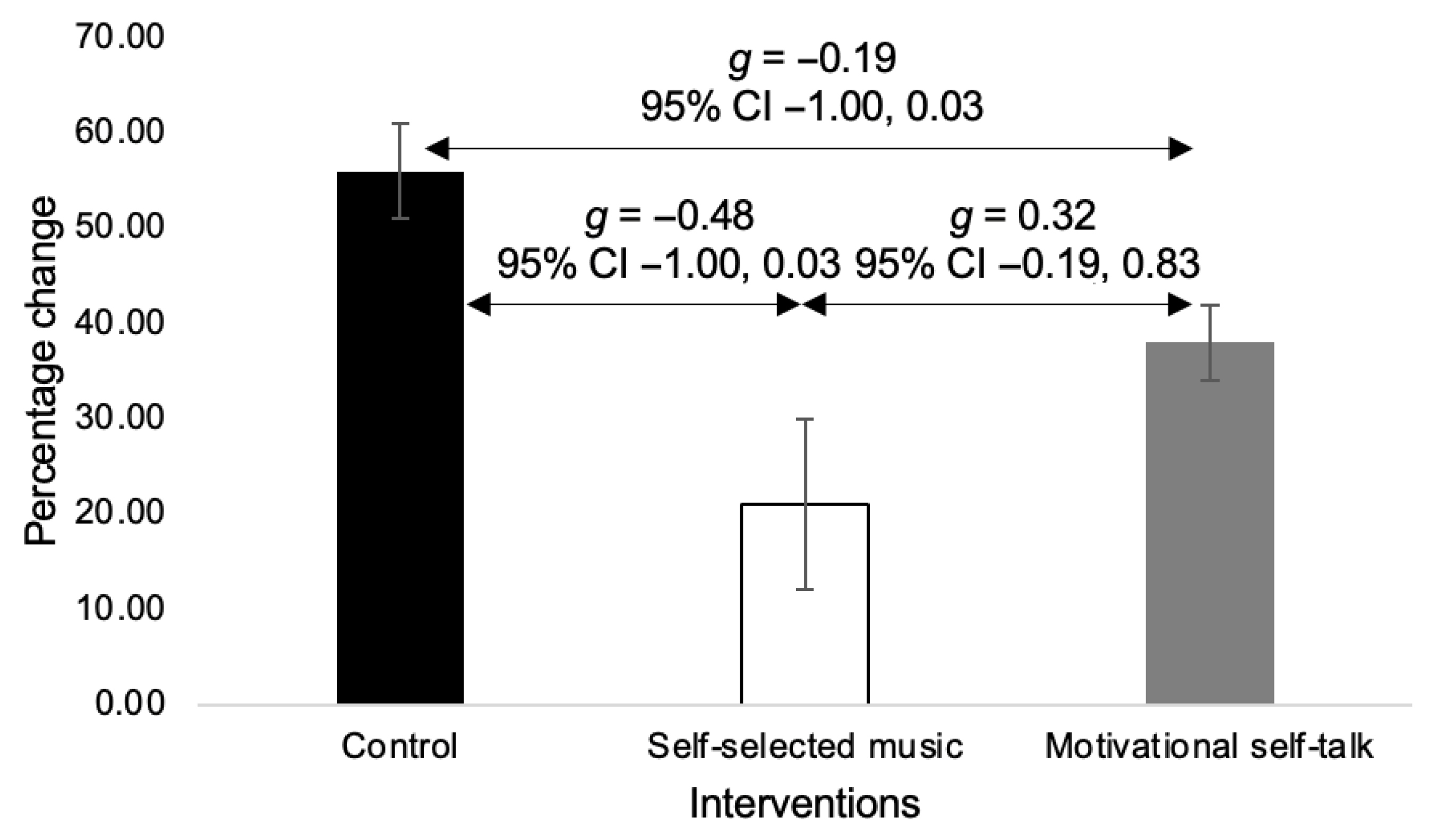
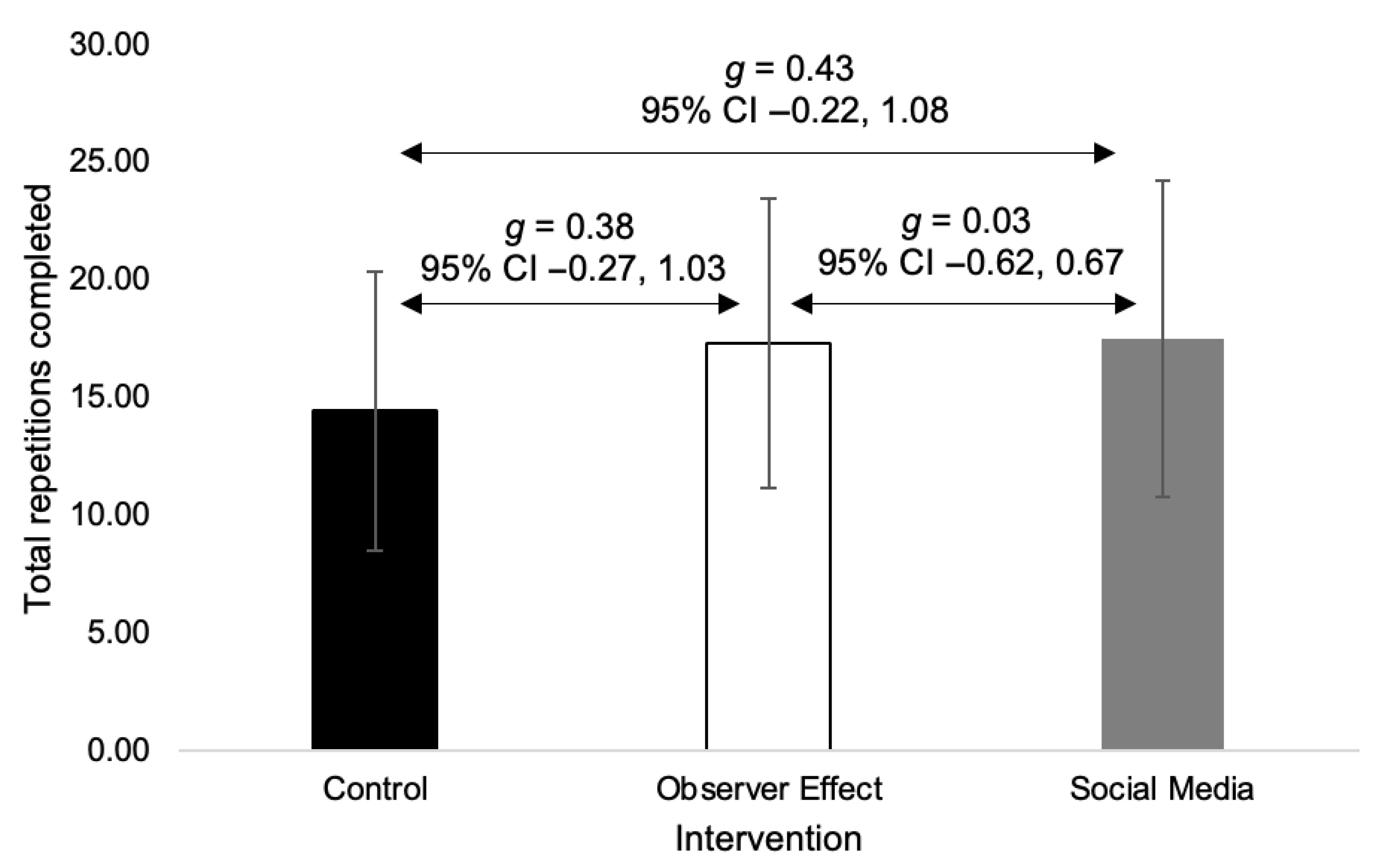
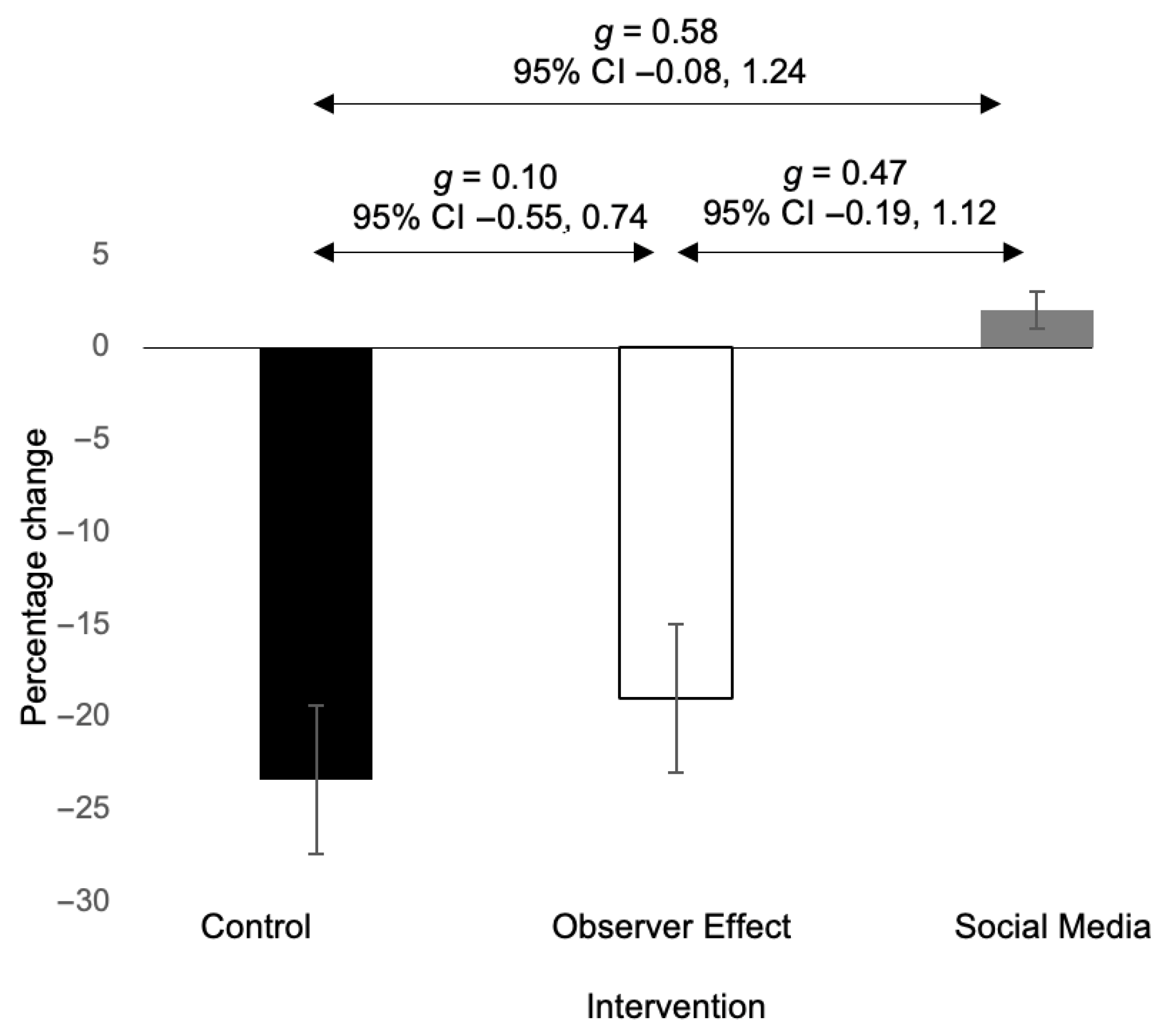
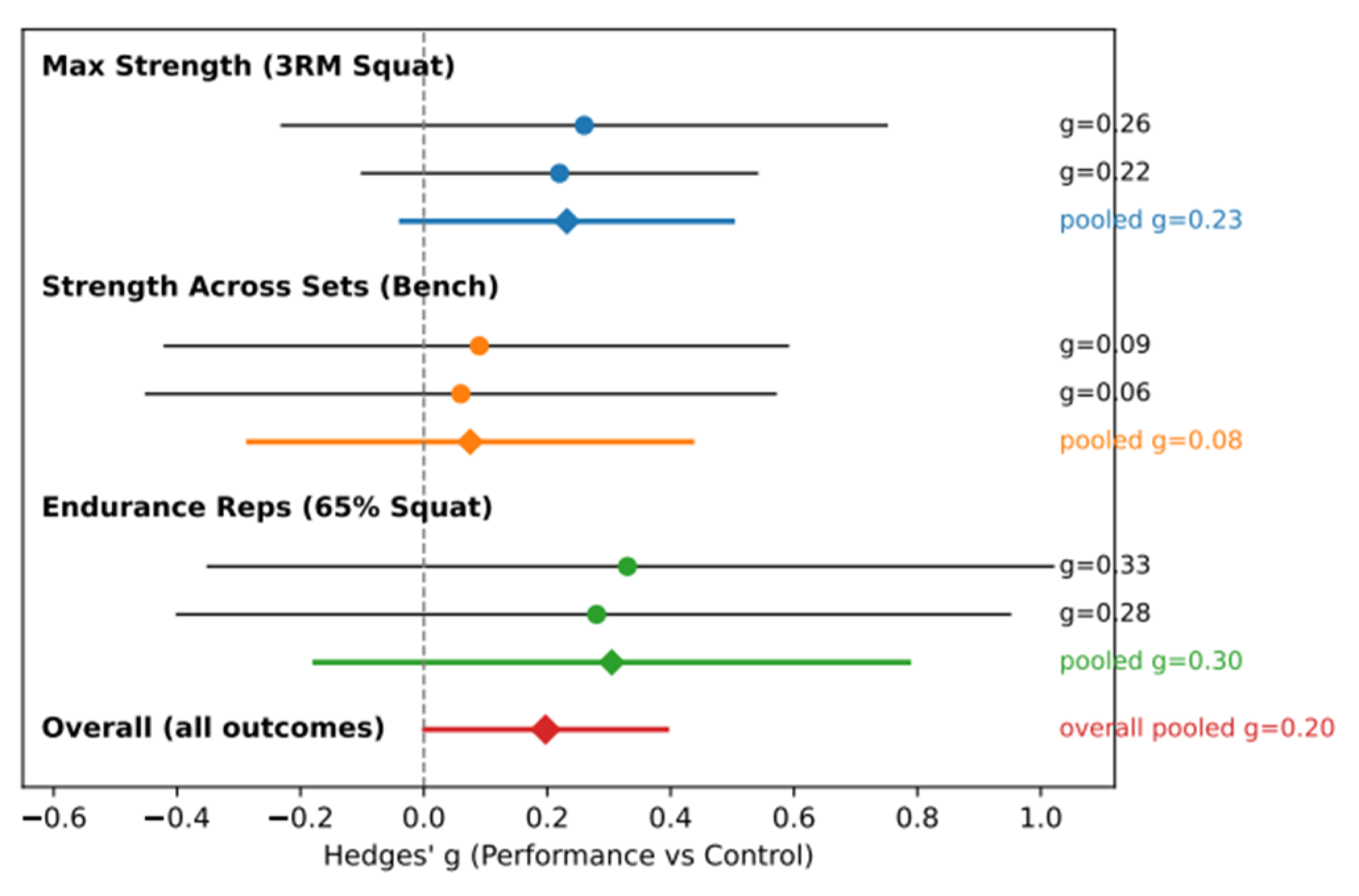
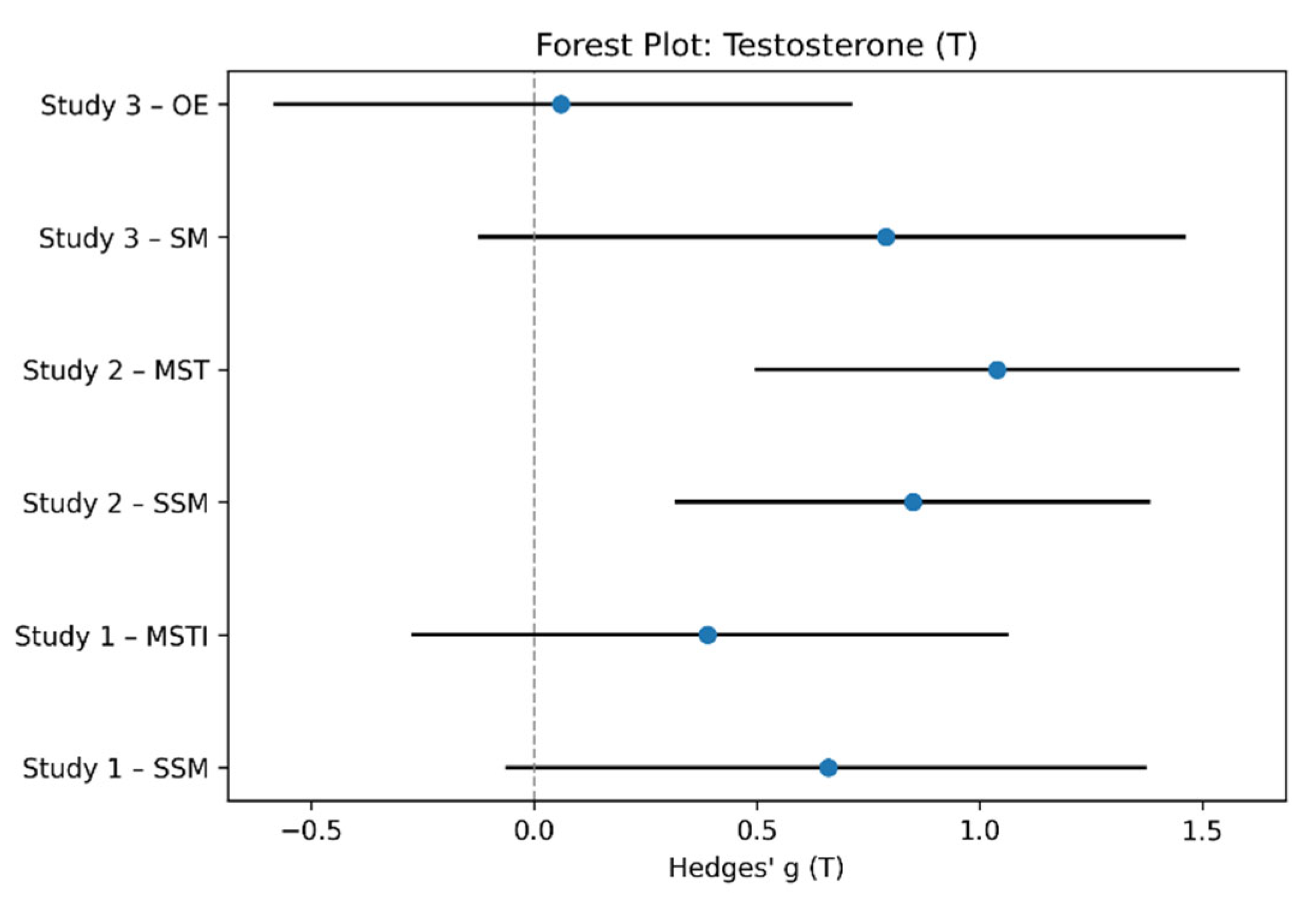

| Study | Primer | Performance Test | Performance Outcome vs. CON | Performance Change | T Change | T:C Change | Interpretation |
|---|---|---|---|---|---|---|---|
| 1 | SSM | 3RM Back Squat | ↑ 6.6% load | g = 0.26 (−0.23, 0.75) | g = 0.66 | g = 0.31 | Small ↑ |
| 1 | MSTI | 3RM Back Squat | ↑ 5.5% load | g = 0.22 (−0.10, 0.54) | g = 0.39 | g = 0.23 | Small ↑ |
| 2 | SSM | 4 × 4RM Bench Press | ↑ 31.26 kg VL | g = 0.09 (−0.42, 0.59) | g = 0.85 | g = −0.4 | Trivial |
| 2 | MST | 4 × 4RM Bench Press | ↑ 21.56 kg VL | g = 0.06 (−0.45, 0.57) | g = 1.04 | g = −0.19 | Trivial |
| 3 | SM | 65% 1RM Squat to Failure | ↑ 2.5 reps | g = 0.33 (−0.35, 1.02) | g = 0.79 | g = 0.58 | Moderate ↑ |
| 3 | OE | 65% 1RM Squat to Failure | ↑ 2.67 reps | g = 0.28 (−0.40, 0.95) | g = 0.06 | g = 0.10 | Small ↑ |
Disclaimer/Publisher’s Note: The statements, opinions and data contained in all publications are solely those of the individual author(s) and contributor(s) and not of MDPI and/or the editor(s). MDPI and/or the editor(s) disclaim responsibility for any injury to people or property resulting from any ideas, methods, instructions or products referred to in the content. |
© 2025 by the authors. Licensee MDPI, Basel, Switzerland. This article is an open access article distributed under the terms and conditions of the Creative Commons Attribution (CC BY) license (https://creativecommons.org/licenses/by/4.0/).
Share and Cite
Collins, J.; Bishop, C.; Spiegelhalter, A.; Wilson, L.; Hills, F.; Turner, A. A Series of Acute Psychological Priming Interventions Assessing Changes in Hormonal and Physical Performance Measures During Resistance Training. Appl. Sci. 2025, 15, 11538. https://doi.org/10.3390/app152111538
Collins J, Bishop C, Spiegelhalter A, Wilson L, Hills F, Turner A. A Series of Acute Psychological Priming Interventions Assessing Changes in Hormonal and Physical Performance Measures During Resistance Training. Applied Sciences. 2025; 15(21):11538. https://doi.org/10.3390/app152111538
Chicago/Turabian StyleCollins, James, Chris Bishop, Abbie Spiegelhalter, Laura Wilson, Frank Hills, and Anthony Turner. 2025. "A Series of Acute Psychological Priming Interventions Assessing Changes in Hormonal and Physical Performance Measures During Resistance Training" Applied Sciences 15, no. 21: 11538. https://doi.org/10.3390/app152111538
APA StyleCollins, J., Bishop, C., Spiegelhalter, A., Wilson, L., Hills, F., & Turner, A. (2025). A Series of Acute Psychological Priming Interventions Assessing Changes in Hormonal and Physical Performance Measures During Resistance Training. Applied Sciences, 15(21), 11538. https://doi.org/10.3390/app152111538








